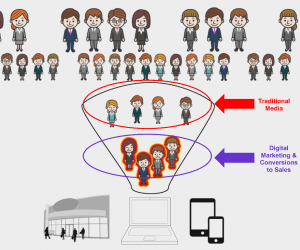


Soon after I posted the article, I received a few comments about the article from a radio executive. His first comment touted the value of radio; his second bashed display ads on the Internet; and his third called the article “the dumbest thing I ever read.”
Whoa! I never realized that what I considered a fairly innocuous article could generate such a negative response! I suppose the commenter was upset because the article did not specifically point to radio as a medium to consider when engaging this particular generation. However, it was clear to me that the article had implied that radio should be part of the traditional strategy mix, even though TV was the only traditional medium I mentioned. (A side note: We absolutely believe in the power of radio as part of the marketing arsenal. In fact, we use the commenter’s radio station for one of our clients.)
Last month I was invited to listen to a television sales executive speak about the values of using TV advertising in a world where digital advertising grows stronger every year. The presentation began with information regarding the new analytics and metrics available to TV advertisers to measure ROI on your TV advertising budget. But it soon evolved into a lecture on how to counter the digital marketing firms banging at the door of the advertisers and asking for a larger share of the marketing budget. At one point, the speaker referred to digital marketing firms as simple “resellers” of Google AdWords campaigns. His remarks, however, didn’t take into account the value of using an experienced AdWords buyer to ensure that an advertiser does not overpay for broad keywords or phrases when choosing and measuring the correct AdWords.
A few months ago I attended a seminar on digital marketing and heard the principal of a digital marketing firm condemn traditional media as “antiquated,” overly expensive, and almost completely ineffective.
In the midst of all this vitriol coming from the digital and the traditional sides, are we marketers doing our clients any favors?
Brad Jakeman, president of PepsiCo Global, commented in a recent Ad Age magazine article about the horrific state of current advertising and marketing, and bashed the polluting nature of campaigns without engagement. He also admonished readers to stop using the term “digital marketing” because it is too limiting.
I agree, but only up to a point. All of these “channels” or “touch points” to the consumer are changing at warp speed, converging into one communications octopus with numerous tentacles. Soon it will be difficult to distinguish what is digital from what is traditional, what is viral, what is public relations, and so forth.
Until we have a new lexicon that everyone is conformable with, we will just have to use the existing terms of “digital” or “new,” “traditional,” and “PR”—as long as we know they all need to be employed in unison in order to have a proficient marketing plan.

As the marketing landscape stands today, TV and radio are amazingly effective, but they are most effective if they are used for reach and for emotional branding at the top of the sales funnel. Once we engage prospects and bring them further into the sales funnel, our digital strategies can be most valuable, particularly if they are used with our clients’ CRM systems.
As prospects reach our website, it is imperative to track and engage our prospects all the way through the process and, finally, convert them into customers. Many companies fall short here because they don’t have an internal team to monitor these prospects. In many retail businesses, if a prospect is not engaged by someone in the company within twenty minutes, the customer leaves your sales funnel and goes to a competitor’s. That means your investments in traditional media to bring them into your sales funnel and the investments you made in your digital strategies are completely wasted.
The other sad result of all this conflict is that compelling, creative has suffered. Even national companies are no longer paying attention to emotionally driven branding campaigns; instead, they are churning out forgettable and often benign creative. However, the idea is to begin with a distinct brand that generates large initial engagement by bringing prospects into the top of the sales funnel. If done successfully, that initial step is followed by a digital strategy that simultaneously reinforces the brand message while taking the prospect further down the sales funnel, focusing more on selling proposition and price. If you execute your strategy this way, the results are high rates of conversions to sales.
Often, we focus so much attention to only one or two ingredients in the marketing cake mix (and don’t see immediate results), that we forget to measure the other ingredients (and lose site of the macro vision of the marketing plan). When it doesn’t work, we quickly discard the strategy for a new plan. Really, though, seeing the entire marketing process through (done correctly) takes patience and endurance. After all, people are bombarded with 5,000 messages a day. If you are a CEO or CMO and your company does not have the resources to afford a full, experienced marketing team, then it is essential to hire a marketing firm that has the acumen to apply the right amount of marketing (within your budget) to each communications channel.
The good news is this: plenty of metrics and analytical tools exist to measure the success of your marketing channels, and that includes measuring your traditional media.

If your company’s marketing is not producing a ROI, contact us today at 215-893-3004. And to view our video on traditional marketing versus digital marketing, click here: https://youtu.be/reB8bm7330A. Also, be sure to see our case studies and client work.
Frank Cerami is President and founder of Cerami Creative , a full-service digital and traditional marketing company founded in Philadelphia, Pennsylvania, in 1995. Cerami Creative has worked with national, regional, and local companies like Yuengling Beer, Penn Medicine, and Rita’s Water Ice.